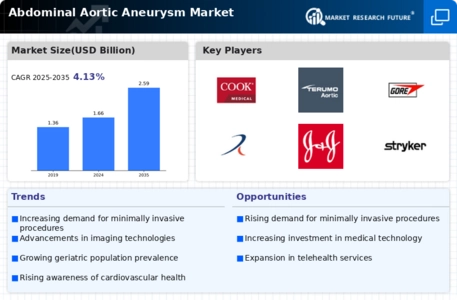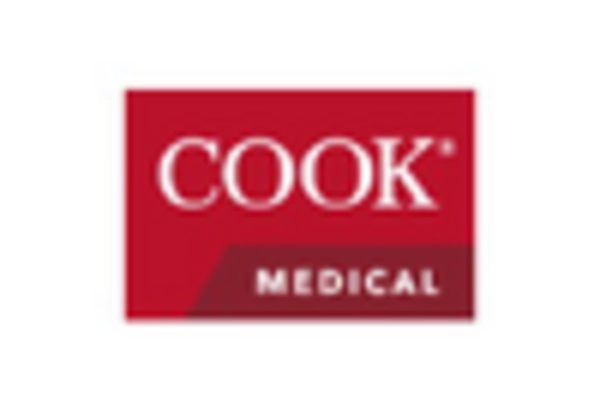Growing Geriatric Population
The increasing geriatric population is a notable driver for the Abdominal Aortic Aneurysm Market. As individuals age, the risk of developing AAAs escalates, making this demographic particularly vulnerable. The World Health Organization projects that the number of people aged 60 years and older will double by 2050, which may lead to a corresponding rise in AAA cases. This demographic shift necessitates enhanced healthcare services tailored to the needs of older adults, including screening and treatment for AAAs. As healthcare systems adapt to accommodate this growing population, the Abdominal Aortic Aneurysm Market is likely to witness substantial growth, reflecting the urgent need for effective management strategies.
Rising Healthcare Expenditure
The increase in healthcare expenditure across various regions is a significant driver for the Abdominal Aortic Aneurysm Market. Governments and private sectors are investing more in healthcare infrastructure, which includes the development of advanced diagnostic and treatment facilities for AAAs. This trend is evident in many countries, where healthcare budgets are being allocated to improve access to quality care. As a result, patients are more likely to receive timely diagnoses and interventions, which can lead to better health outcomes. The growing financial commitment to healthcare is likely to stimulate demand for AAA-related products and services, thereby propelling the Abdominal Aortic Aneurysm Market forward.
Enhanced Diagnostic Technologies
The evolution of diagnostic technologies plays a pivotal role in shaping the Abdominal Aortic Aneurysm Market. Advanced imaging techniques, such as high-resolution ultrasound and computed tomography (CT) scans, have improved the accuracy of AAA detection and monitoring. These innovations facilitate early diagnosis, which is crucial for effective treatment and management of the condition. As healthcare providers increasingly adopt these technologies, the likelihood of identifying AAAs at earlier stages rises, potentially leading to better patient outcomes. Consequently, the demand for diagnostic tools and services is expected to grow, further driving the expansion of the Abdominal Aortic Aneurysm Market.
Increasing Incidence of Aneurysms
The rising prevalence of abdominal aortic aneurysms (AAAs) is a critical driver for the Abdominal Aortic Aneurysm Market. Factors such as an aging population and lifestyle choices, including smoking and obesity, contribute to this trend. According to health statistics, the incidence of AAAs is projected to increase, particularly among older adults. This demographic shift necessitates enhanced screening and treatment options, thereby expanding the market. Furthermore, the growing recognition of risk factors associated with AAAs has led to increased screening initiatives, which may further elevate the demand for medical interventions. As healthcare systems adapt to these changes, the Abdominal Aortic Aneurysm Market is likely to experience significant growth in response to the rising need for effective management and treatment solutions.
Advancements in Surgical Techniques
Innovations in surgical techniques and technologies are transforming the landscape of the Abdominal Aortic Aneurysm Market. Minimally invasive procedures, such as endovascular aneurysm repair (EVAR), have gained traction due to their reduced recovery times and lower complication rates compared to traditional open surgery. These advancements not only enhance patient outcomes but also drive market growth by attracting more patients seeking effective treatment options. The introduction of new devices and materials, such as advanced stent grafts, further supports this trend. As healthcare providers increasingly adopt these innovative techniques, the Abdominal Aortic Aneurysm Market is poised for expansion, reflecting the ongoing evolution of surgical practices and patient care.


















Leave a Comment